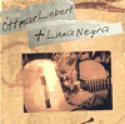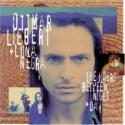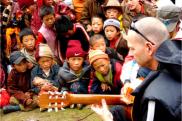|§| Ottmar Liebert's heading for a gig in Austin, Texas, 2005 or maybe it's 06, he's not sure because he's wondering if in fact he dreamed this: the snow storm, the tour bus labouring down from the Stockton Plateau on a back road near the I 10 which was shut down because of a big multi-vehicle crash, weather so bad even the coyotes were staying home in bed. Driver sees this man on the shoulder, barely moving. "We had to stop," says OL. "This was the middle of nowhere and I mean, it was brutal out there. Native American, Indian, possibly Mexican... was wearing a cloak and hat in the old desert style. He sat up front with our driver, drank coffee, and we let him out in El Rondo, near the Burger King. I didn't talk to him but he caught my eye as the bus was pulling away... and it struck me that I knew him from someplace. It was much later when I thought about my old friend Frank Howell and his paintings, especially the one called The Messenger. So you see, when I'm looking through the bus window at this stranger, maybe I'm not looking at a face, I'm looking at a painting or...."
Was this stranger in the snow a messenger?
"In my dream he left behind a CD, a data disc with no writing on it, like a master. When I listened to it, it was me & Luna Negra, although the tunes weren't anything I'd written. The music was beautiful, like something I wanted to do but hadn't."
Frank Howell died suddenly in 1997. "He was a gentleman," says OL. "We only had a handshake-agreement regarding Nouveau Flamenco, but he didn't flinch when he handed over the master at the end of 1990."


Visual art is integral to Ottmar Liebert's world-view -- in his youth he studied graphic design in Cologne, Germany, and to this day is a compulsive photographer -- because, like flamenco, painting is an integer between the flesh and the spirit. "My music is visual," says OL. "Santa Fe has great light, that special thing you get in the high desert. Some days you can see for a 100 miles, think you can reach into the sky or walk off a ridge and keep flying. Guess that's how I felt when I recorded Nouveau Flamenco."
Nouveau Flamenco. Recorded for less than $3,000 in a shack beside a gravel pit on an old analogue reeler, this CD became an international sensation, went Platinum in six years, established OL's unique border-style flamenco. The album's genesis is a classic tale of independent expression as entrepreneurial karma. Local Santa Fe artist Frank Howell wanted an audio illustration for his series of lithographs Marita: Shadows and Storms and arranged for the pressing of a limited edition (1000 copies) CD to be distributed with his prints. "Frank had a tradition of producing a music project, which would be revealed and distributed during his annual Indian Market Gallery party," says OL. "Someone in his office sent out a few promo copies of Marita to some radio stations and it just took off."
Indeed it did. Programmers added tracks to their playlists and soon stations like KKSF in San Francisco and The Wave in L.A. were making hits out of "Santa Fe" and "Barcelona Nights". This "new flamenco" came to the attention of Higher Octave Music, a label in Los Angeles, who remastered Marita and released it in 1990 as Nouveau Flamenco.
The title, as most know, was a joke, a play on "nuevo flamenco", was an outsider's deference to the gypsy core of flamenco. Or it was a cheeky statement by a citizen of the punk generation, appropriating flamenco for his own creative purposes. "I wanted to make the rumba rhythm more groove-oriented," says OL. "I felt this new music would relate to Flamenco the way Bossa Nova relates to Samba."
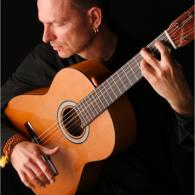
Marita: Shadow & Storms
"Frank heard me playing somewhere in the summer of 1989, suggested the project. I recorded the album in 3 weeks. Frank entitled the album Marita: Shadows and Storms and named most of the tracks. Our handshake agreement was that he would press 1,000 CDs which he would give away to clients and friends, and sell at his gallery, and then he would give me the master free and clear."

"There's a supernatural feel about Frank's painting," says OL. "Like looking in a mirror and finding the spirit world.
"I preferred his drawings which grabbed me more, but he rarely showed them. His paintings were pretty slick and while impressive, didn't move me as much. He was a gentleman. We only had a handshake-agreement regarding Nouveau Flamenco, but he didn't flinch when he handed over the master at the end of 1990. While I was working on NF, Frank told me stories about a summer he spent in Portugal, following the great Fado singer Amália Rodrigues from gig to gig in a rented Porsche 911. This was sometime in the early Eighties, I think. The piece Flowers of Romance was inspired by that story."
nouveau flamenco
“I was honestly happy playing this music in hotels and restaurants in Santa Fe. In one year, going from doing that to opening for Miles Davis was a pretty intense jump. Most shocking for me was to realize how many different people from so many diverse cultures embraced it.”
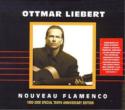
"I wasn't wild about the Higher Octave remaster," says OL. ""They boosted the volume so much that radio-stations actually had to remember to turn it down, because it would overload their signal. However, I can't dispute the record's success and that it gave me the opportunity to play in a wide variety of cultural settings with musicians from around the world, and that has been a great experience, too."
Ottmar Liebert & Luna Negra
Jon Gagan, bassist: "We toured incessantly as a trio with Dave Bryant on percussion for two years in '90 and '91. Just the 3 of us with Stefan Liebert as tour manager and front-of-house sound man. We opened for Miles and did two tours opening for Basia. I loved that group because we had to bring some jazz and even power-trio elements to it in order to stir it up with 3 guys for these big shows. Lots of group improvising and throwing the ball around with the solos. Being that Ottmar was still building his name, we had a lot to prove, and it was a great challenge."
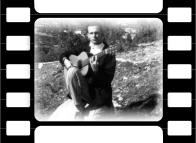

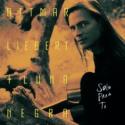
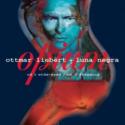
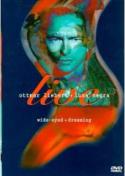 (see/hear OL talking about noise & silence on the
1996 Sony DVD Wide-Eyed + Dreaming)
(see/hear OL talking about noise & silence on the
1996 Sony DVD Wide-Eyed + Dreaming)